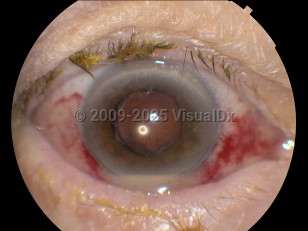Endophthalmitis - External and Internal Eye
Alerts and Notices
Important News & Links
Synopsis

Patients most at risk for endophthalmitis are those who have had previous eye trauma or surgery. Fungal endophthalmitis is most commonly found following severe eye trauma or severe corneal ulcer infections. There has been concern in recent years of an increased incidence of endophthalmitis, ranging from 0.1% to 0.18%, that appears to be associated with clear corneal nonsutured temporal incision cataract surgery. Rupture of the posterior lens capsule during cataract surgery is associated with an increased risk of endophthalmitis. The patient's external eyelid skin and lashes provide the major sources of infection during intraocular surgery.
Endogenous endophthalmitis occurs when microorganisms cross the blood-ocular barrier and multiply within the eye. An immunocompromised state, intravenous drug use, gastrointestinal procedures (eg, endoscopy), central venous catheters (current or recent), endocarditis, and other systemic infections increase one's risk of endogenous endophthalmitis. Both eyes may be affected. Many patients with endogenous bacterial endophthalmitis have prolonged courses of disease due to initial misdiagnosis. Visual outcomes are typically poor, often resulting in blindness of the affected eye(s).
Patients typically present acutely with pain and loss of vision. Pain may be a late-presenting symptom. With more subacute or chronic infections, blurred vision can be the presenting symptom, or the patient can be asymptomatic.
The critical sign on eye examination is that there is inflammation in the vitreous. Often there will be a poor view of the fundus due to vitreous inflammation. There may also be a hypopyon in the anterior chamber, which can be a collection of pus and/or inflammatory cells.
Codes
H44.19 – Other endophthalmitis
SNOMEDCT:
1847009 – Endophthalmitis
Look For
Subscription Required
Diagnostic Pearls
Subscription Required
Differential Diagnosis & Pitfalls

Subscription Required
Best Tests
Subscription Required
Management Pearls
Subscription Required
Therapy
Subscription Required
Drug Reaction Data
Subscription Required
References
Subscription Required

